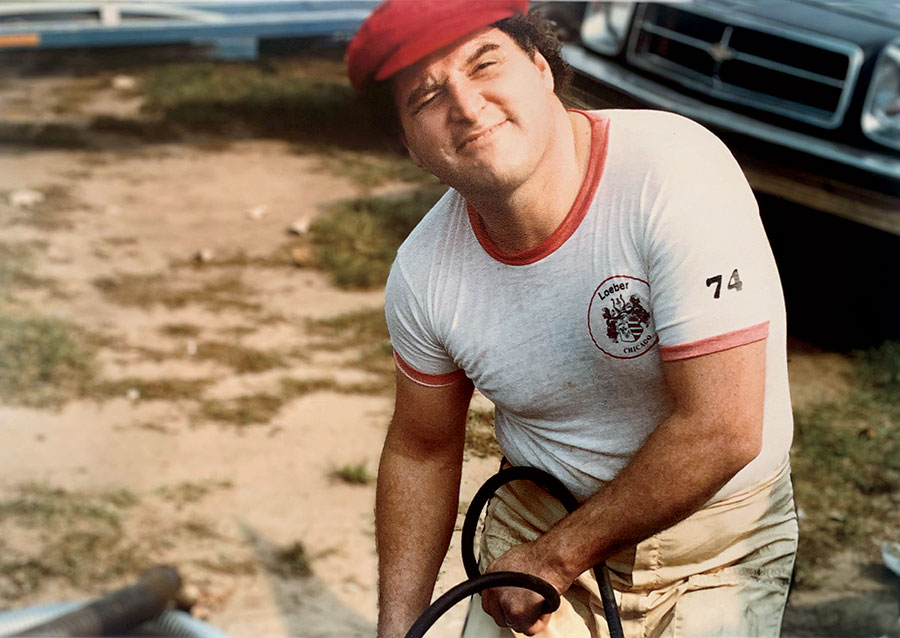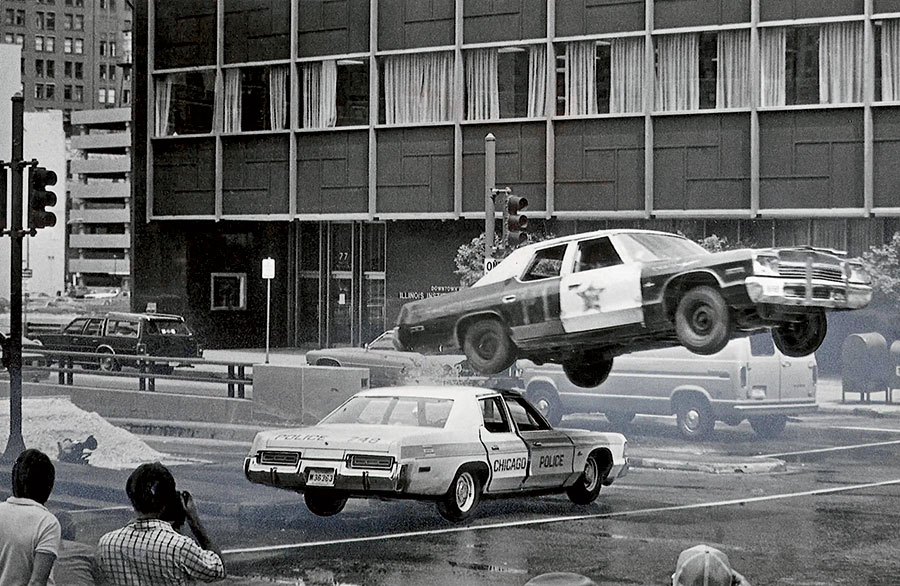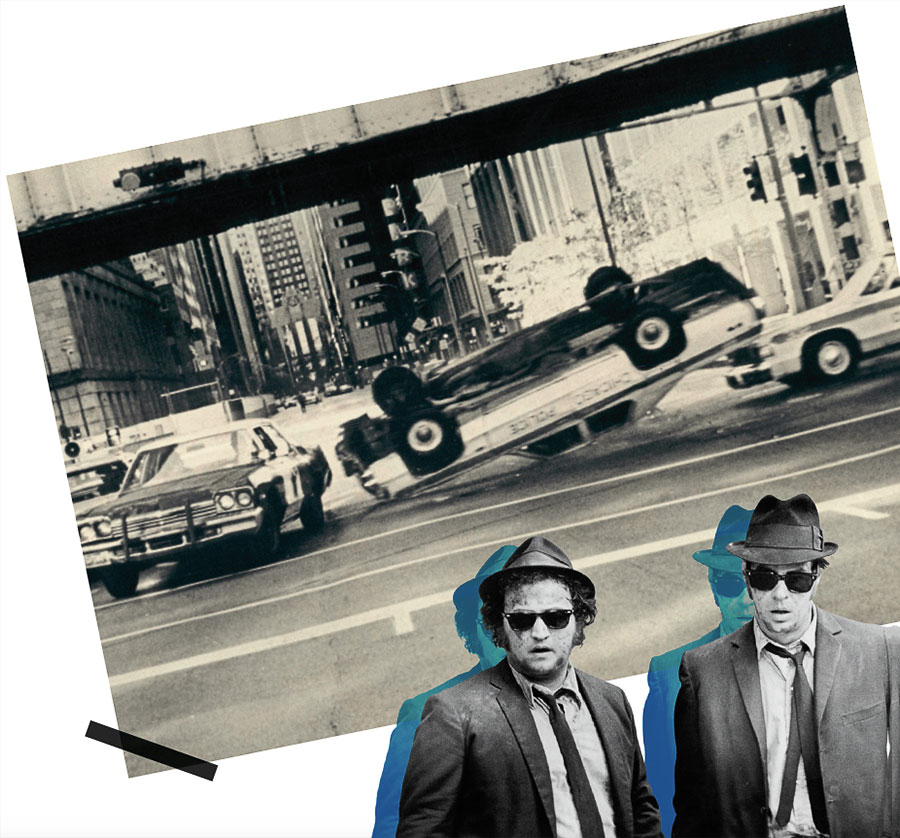It was the late spring of 1979, and I’d recently left my job selling high-line cars at Loeber Motors on Clark Street, a couple of blocks from Rush Street’s corridor of nightclubs. The dealership was still sponsoring my Alfa Romeo racecar (we were winning quite a few races that year, which made George Loeber happy), and I’d drop by regularly to pick up parts or just to see how things were going.
It was on such a visit that I noticed these two guys in George’s office. One wore a high-mileage three-piece suit, and the other was in shirtsleeves and dungarees and sported unruly hair, an extravagant mustache, and large, copper-tinted sunglasses. It turned out the suit was from Mayor Jane Byrne’s film office and the other guy was some sort of advance-organizer wheel from Hollywood. Their shared mission was to help facilitate the upcoming Chicago shoot of John Landis’s The Blues Brothers.
The two were asking George where they might find reliable, trustworthy drivers who could handle an automobile “at speed” and, moreover, would work for cheap and show up at 5 a.m. as needed. That’s when George noticed me wandering through the showroom and beckoned me into his office. “You might ask this guy,” he told them as he fiddled with his pipe. “He races cars.”
The two guys eyed me. “Izzat right?” the City Hall guy said.
I gave him one of those half-nod, half-shrug things and tried to stand up a little straighter. The two looked at each other and then back at me.
They invited me to a tryout — to be held in the exceedingly vacant parking lot of the recently defunct and now derelict Dixie Square Mall in Harvey — and told me to bring any of my racing buddies along who might be interested.
On the day of the audition, I arrived at the mall and spotted four beat-up cop cars parked in a ragged line, plus a card table manned by some production-assistant types. A couple of bored-looking Hollywood stunt drivers — real ones! — leaned against the side of the van, smoking cigarettes and drinking coffee.
There were probably no more than a dozen of us. But we discovered there would be fresh waves of tryouts all day. The Blues Brothers project had a lot of cop cars to fill. And the producers, I recall hearing, were dead set against paying union-scale stunt money to fill all the drivers’ seats. Hell, those cars would mostly serve as moving background in the big chase scenes anyway.

I was one of the first to sign my release and get behind the wheel of a shopworn squad car for my test. The assistant stunt coordinator who got in next to me was a wiry-looking guy with a California tan and a neat helmet of salt-and-pepper hair. He was carrying a folded-up copy of that morning’s Tribune. When he introduced himself, I recognized his name, J.N. Roberts, immediately. He’d been a top California enduro and desert racer and had even been featured in Bruce Brown’s wonderful biker documentary, On Any Sunday.
He gave me a half-watt glow of acknowledgment when I told him I knew who he was. But after that, it was all business, starting with his perfunctory spiel: “First, put your seat belt on. Then start the car, put it in gear with the brake on, and listen to what I tell you to do. Make sure you do exactly what I tell you to do, and don’t do anything until or unless I tell you to do it.” He glanced over at me. “Do you understand?”
I nodded as I clipped the belt home. Then I fired up that big, rumbling Dodge 440 and listened to it settle into an uncertain lope of an idle.
He nodded and looked down at the newspaper in his lap. “OK, now accelerate hard as you can toward that orange pylon at the far edge of the parking lot.”
At first I couldn’t see it, among the tangled weeds, scrawny trees, and wildflowers at the end of the pavement, what seemed like half a mile away. But I finally made out a two-foot-high traffic cone. As instructed, I floored it.
The old Dodge creaked as it lunged forward, like a washed-up offensive lineman running on just fumes and memory. It wasn’t exactly neck-snapping. But there were seven-plus liters of muscle under the hood, and the Dodge kept gaining speed as I held my foot to the floor. J.N. was still looking at his newspaper — the entertainment section, I think — as the Dodge oozed into second gear. Then third. I could feel the shimmy, shake, and wander of the car’s beat-to-crap front end through the steering wheel. “I think this one has a bad tie-rod end,” I offered. “Or maybe it’s the steering-rack bushings?”
“What makes you think so?” J.N. asked without looking up from his paper.
“I can feel it.”
He didn’t say anything. And by now those trees and weeds at the far edge were looming large. The pavement was rough out there, so the big Dodge was dancing all over the place like a bug on a hot griddle. But I kept my foot in it, just like J.N. said. Out of the corner of my eye, I saw his eyes swivel slowly upward. We were really getting close now.
“OK,” he said, like it was no big deal, “you can back out of it.”
I lifted off the gas and pressed hard on the brake. But not too hard. I knew better than to slam on it and lock up the wheels.
And that was it. I’d passed.
If you didn’t lift off until your stunt coordinator told you to, you were in. The whole thing took less than 30 seconds.
On the first day of shooting, in a patch of rail yard-adjacent wasteland off the Eisenhower, J.N. appeared in front of me out of nowhere. “How’s that squad car you drove over?” he asked.
“It’s shit,” I told him. “There’s something wobbly in the right front and a bad vibration from the drive shaft and —”
“Find us a good one, OK?” he said. “They should all have keys in the ignitions. Then park it over there behind the pickup with the Bluesmobile on the back.”
I felt like a sneak thief as I climbed into one squad after another and ran them around the perimeter of the staging area. But nobody seemed to care, so long as I stayed away from the camera crews doing setup. Eventually I found a squad that felt reasonable — no glaring faults or shortcomings — and duly parked it behind the three-quarter Bluesmobile mounted on the flatbed and brought J.N. the keys. “Thanks,” he said. “You can ride with me on this first run if you want to.”
That sounded pretty damn neat.
The first shot took most of the morning just to set up. But finally, all the squad cars were ready to go, ad hoc stunt drivers inside, and I climbed in that first squad car on the passenger side, next to J.N. They wanted “real” stuntmen driving those first few cars, and they wanted two cops in each one. After that, it didn’t much matter, so long as there was plenty of movement and action.
It was a fairly simple shot, just sashaying through Lower Wacker Drive behind the Bluesmobile-on-a-flatbed, and it wasn’t even that fast. Still, it was sort of frantic, like that clattery Ghost Train ride at the old Riverview Park. There’s a lot of very solid stuff you can hit on Lower Wacker Drive — concrete islands and curbs and columns and such — and the pavement was, well, what you might expect of Chicago pavement.
Who would have guessed that all those Sunday morning hours spent doing doughnuts in snow-covered parking lots would come in so handy?
We weaved through Lower Wacker until we got to Lower Michigan Avenue, then made a triangular about-face and duplicated the same weaving-and-squealing queue behind the Bluesmobile until we arrived back at the rail yard where we’d started. The whole deal took maybe 10 minutes, and probably yielded 10 seconds of actual, usable screen time.
But of course that was just one shot. And so while they set up the next one, which took well over an hour, we waited around some more. J.N. told me to get my own cop car and get in line behind the three pro stunt drivers for the next take. This time we were going to chase after the stunt doubles who were in one of the real Bluesmobiles. I noticed a bunch of air was being let out of its rear tires so that it would slide around more on Lower Wacker’s slick, bumpy concrete. So I did the same on my cop car. Hey, why not?
This next shot was the only one where you can catch a glimpse of me in the finished movie. I’m the fourth squad car back. Ahead of me, there was the camera car, followed by the Bluesmobile, and then the three real stunt guys in their cop cars, then me, doing my level best to steal the scene by getting my car as ridiculously sideways as possible at every opportunity. Who would have guessed that all those Sunday morning hours spent doing doughnuts and broad-sliding figure eights in snow-covered high school parking lots would come in so handy?
The plan was to follow Lower Wacker again, then take a tire-squealing left onto Lower Michigan Avenue to cross the medieval-looking drawbridge that spans the Chicago River. And then, about four blocks up, just before Lower Michigan comes to an abrupt T-intersection end at Grand, the Bluesmobile was supposed to attempt a too-fast left turn, do a neat, tire-smoking 180, and immediately charge off in the opposite direction, thereby eluding all the pursuing cop cars. Got it?
They’d jimmied the ratcheting mechanism on the Bluesmobile’s parking brake so the stunt driver could yank it and goad the car into a spin on its underinflated rear tires. (See almost any episode of The Rockford Files.) Only it didn’t quite work when the cameras were rolling. The Bluesmobile’s engine stalled out during that big, wild fishtail when the stunt driver yanked on the hand brake, and it upset the car’s hoped-for trajectory. The Bluesmobile squeegeed its way to a grim, tinny halt against the opposing concrete island. Thunk! Damn.
And then it wouldn’t restart. Meanwhile, the real cops who were there to handle traffic control were starting to get a lot of flak and horn honking from all the real Chicago workers, taxi and delivery drivers, and ordinary citizens who wanted to use Lower Wacker Drive that morning.
It was decided to call for a tow truck and send the rest of us back from whence we came. Where we proceeded to wait around some more.

Dan Aykroyd, who is a genuine car and motorcycle nut, wanted to drive one of the stunt cars. The legal types on hand didn’t like that. So then he asked if he could just ride along in one of the stunt cars. And I think that may have actually happened. But the cool thing was the deference and respect that Aykroyd showed when talking with the stunt guys. They thought he was cool, but he thought they were even cooler.
We did a few more shots that afternoon before it was time to call it a day. We put burlap sacks over the roof lights and funeral-processioned our way on the expressway back to the warehouse, where we checked in our cop cars and uniforms and then (and only then) got our somewhat embarrassing checks for that day’s shooting. It was less than you’d make flipping burgers.
But it was still foreign and fun and fascinating, and I decided to hang around awhile and check out the squad cars that were being prepared for various stunts. A couple of guys were putting a Hollywood staple, “sugar glass,” into the windshields and side windows of all the soon-to-be-crashed cars. That’s the stuff that shatters gloriously — just like real glass — only it’s made out of sugar and water, like candy, and the fragments and flying bits are about as dangerous as paper confetti.
I noticed that one of the state police cars was being prepped for something special. Besides putting in the sugar-glass windows, the shop guys had cut nearly all the way through the car’s A, B, and C pillars, which support the roof. You almost couldn’t see the rotary-saw cuts, but close inspection revealed them at about three-quarters of an inch above the belt line. There was just about an eighth of an inch of uncut metal remaining on each pillar. Think of a tooth that’s ready to fall out.
I asked the guy working under the steering wheel what all this was for. “This one’s gonna get decapitated,” he said, like it happened every day.
“Sounds exciting.”
“It’ll be real exciting for the poor fish inside.”
He stepped out to show me his handiwork. There was a padded bucket seat, but it had been mounted on a rocker mechanism so when you pulled on this red lever that sprouted out of the seat frame, the seat would instantly whap over backward — like a mousetrap! — to the floor. He tried it several times to make sure it was working properly. Then he shook his head. “None of the regular stunt guys are going to want any part of this gag.”
“Too dangerous?”
“Just too many little things that could go wrong.” He looked at me. “You’re not even supposed to be in here, are you?”
“I’m one of the drivers,” I explained. “For the cop cars.”
“Local talent, huh?”
“A star in the making.”
That rated a thin smile.
“Say,” I said, “I do a little racing, and I was thinking that one of these old cop cars would make a pretty good tow vehicle. They’ve got the big cop motors and the cop brakes and suspensions. One of the stunt guys told me the film people only paid two hunnert bucks each for them. So I was wondering, when the filming’s all done, if I could maybe buy one? Hell, I’d double what you paid — four hunnert bucks, cash American! And I wouldn’t need the roof lights or anything.”
He shook his head and smiled. “The way I understand it, there won’t be any of them left.”



